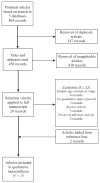Reducing youth screen time: qualitative metasynthesis of findings on barriers and facilitators
- PMID: 25822054
- PMCID: PMC4456186
- DOI: 10.1037/hea0000172
Reducing youth screen time: qualitative metasynthesis of findings on barriers and facilitators
Abstract
Objective: An integrated perspective on the relevant qualitative findings on the experience of screen time in youth can inform the development of hypotheses to be tested in future research and can guide the development of interventions to decrease sedentary behavior. The purpose of this qualitative metasynthesis was to explore parent, youth, and educational professionals' perceptions of barriers to, and facilitators of, reducing youth screen time.
Method: Qualitative metasynthesis techniques were used to analyze and synthesize 15 qualitative studies of screen time among youth (11-18 years) meeting inclusion criteria. The phrases, quotes, and/or author interpretations (i.e., theme or subtheme) were recorded in a data display matrix to facilitate article comparisons. Codes were collapsed into 23 categories of similar conceptual meaning and 3 overarching themes were derived using thematic analysis procedures.
Results: Study sample sizes ranged from 6 to 270 participants from 6 countries. Data collection methods included focus groups (n = 6), interviews (n = 4), focus group and interviews (n = 4), and naturalistic observation (n = 1) with youth and/or parents. Data analysis techniques included thematic analysis (n = 9), content analysis (n = 3), grounded theory (n = 1), observation (n = 1), and interpretive phenomenological analysis (n = 1). Three thematic categories were identified: (a) youth's norms-screen time is an integral part of daily life, and facilitates opportunities for entertainment, social interaction, and escapism; (b) family dynamics and parental roles-parents are conflicted and send mixed messages about the appropriate uses and amounts of screen time; and, (c) resources and environment-engagement in screen time is dependent on school, community, neighborhood, and home environmental contexts.
Conclusions: Screen time is an established norm in many youth cultures, presenting barriers to behavior change. Parents recognize the importance of reducing youth screen time, but model and promote engagement themselves. For youth and parents, mutually agreed rules, limits, and parental monitoring of screen time were perceived as likely to be effective.
(c) 2015 APA, all rights reserved).
Figures
Similar articles
-
The influence of friends and siblings on the physical activity and screen viewing behaviours of children aged 5-6 years: a qualitative analysis of parent interviews.BMJ Open. 2015 May 14;5(5):e006593. doi: 10.1136/bmjopen-2014-006593. BMJ Open. 2015. PMID: 25976759 Free PMC article.
-
Influence of limit-setting and participation in physical activity on youth screen time.Pediatrics. 2010 Jul;126(1):e89-96. doi: 10.1542/peds.2009-3374. Epub 2010 Jun 14. Pediatrics. 2010. PMID: 20547642
-
Managing the screen-viewing behaviours of children aged 5-6 years: a qualitative analysis of parental strategies.BMJ Open. 2016 Mar 1;6(3):e010355. doi: 10.1136/bmjopen-2015-010355. BMJ Open. 2016. PMID: 26932143 Free PMC article.
-
Qualitative Interpretive Metasynthesis of Parents' Experiences of Perinatal Loss.J Obstet Gynecol Neonatal Nurs. 2021 Jan;50(1):20-29. doi: 10.1016/j.jogn.2020.10.004. Epub 2020 Nov 16. J Obstet Gynecol Neonatal Nurs. 2021. PMID: 33212051 Review.
-
Barriers and facilitators to physical activity among ethnic Chinese children: a qualitative systematic review.JBI Evid Synth. 2020 Dec;18(12):2445-2511. doi: 10.11124/JBISRIR-D-19-00154. JBI Evid Synth. 2020. PMID: 32833787
Cited by
-
Movement Behaviors and Perceived Loneliness and Sadness within Alaskan Adolescents.Int J Environ Res Public Health. 2020 Sep 20;17(18):6866. doi: 10.3390/ijerph17186866. Int J Environ Res Public Health. 2020. PMID: 32962220 Free PMC article.
-
Computer vision syndrome: a comprehensive literature review.Future Sci OA. 2025 Dec;11(1):2476923. doi: 10.1080/20565623.2025.2476923. Epub 2025 Mar 8. Future Sci OA. 2025. PMID: 40055942 Free PMC article. Review.
-
COVID-19 and screen-based sedentary behaviour: Systematic review of digital screen time and metabolic syndrome in adolescents.PLoS One. 2022 Mar 21;17(3):e0265560. doi: 10.1371/journal.pone.0265560. eCollection 2022. PLoS One. 2022. PMID: 35312701 Free PMC article.
-
Predictors of Parental Barriers to Reduce Excessive Child Screen Time Among Parents of Under-Five Children in Selangor, Malaysia: Cross-sectional Study.J Med Internet Res. 2021 Apr 13;23(4):e25219. doi: 10.2196/25219. J Med Internet Res. 2021. PMID: 33847590 Free PMC article.
-
Classroom Standing Desks and Sedentary Behavior: A Systematic Review.Pediatrics. 2016 Feb;137(2):e20153087. doi: 10.1542/peds.2015-3087. Epub 2016 Jan 22. Pediatrics. 2016. PMID: 26801914 Free PMC article.
References
-
- Allender S, Cowburn G, Foster C. Understanding participation in sport and physical activity among children and adults: A review of qualitative studies. Health Education Research. 2006;21:826–835. http://dx.doi.org/10.1093/her/cyl063. - DOI - PubMed
-
- American Academy of Pediatrics. American Academy of Pediatrics: Children, adolescents, and television. Pediatrics. 2001;107:423–426. http://dx.doi.org/10.1542/peds.107.2.423. - DOI - PubMed
-
- American Academy of Pediatrics. Council on Communications Media: Children, adolescents, and the media. Pediatrics. 2013:958–961. Advance online publication. - PubMed
-
- Bar-Or O, Foreyt J, Bouchard C, Brownell KD, Dietz WH, Ravussin E, Torun B. Physical activity, genetic, and nutritional considerations in childhood weight management. Medicine & Science in Sports & Exercise. 1998;30:2–10. http://dx.doi.org/10.1097/00005768-199801000-00002. - DOI - PubMed
-
- Bélanger M, Casey M, Cormier M, Filion AL, Martin G, Aubut S, Beauchamp J. Maintenance and decline of physical activity during adolescence: Insights from a qualitative study. The International Journal of Behavioral Nutrition and Physical Activity. 2011;8:117. http://dx.doi.org/10.1186/1479-5868-8-117. - DOI - PMC - PubMed
Publication types
MeSH terms
Grants and funding
LinkOut - more resources
Full Text Sources
Other Literature Sources
Medical


